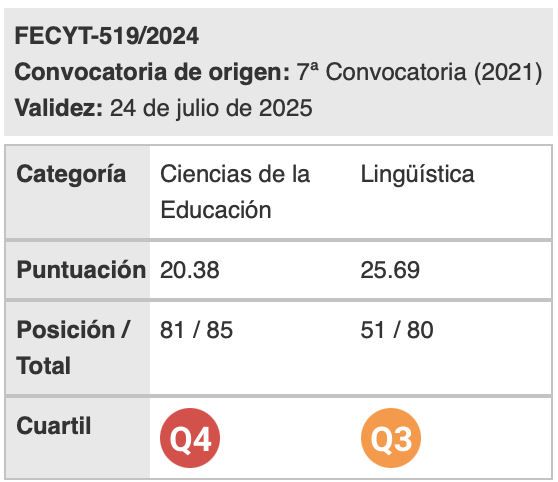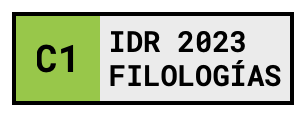Spanish for nursing: A needs analysis for a Spanish for nursing course
Palabras clave:
español, lengua para fines específicos, lengua para la atención sanitaria, análisis de necesidades, lengua para enfermeríaResumen
La investigación ha demostrado que las barreras del idioma pueden impedir el acceso a la atención médica y afectar los resultados de la atención médica. Los cursos tradicionales de español han sido criticados por no abordar de manera efectiva las necesidades específicas de los estudiantes, mientras que los cursos de Lenguaje para Fines Específicos (LSP) sobre atención médica a menudo carecen de una base metodológica creíble. El estudio actual utiliza un marco de enseñanza de idiomas basado en tareas (TBLT) para realizar un análisis de necesidades que explora las necesidades más vitales del idioma español de las enfermeras y, al mismo tiempo, evalúa la eficacia de la enseñanza previa del idioma para satisfacer esas necesidades. Las encuestas y entrevistas entre 45 enfermeras y estudiantes avanzados de enfermería muestran que la mayoría de los participantes reconocieron la necesidad de instrucción en español basada en la atención médica. El análisis descubrió características lingüísticas específicas y tareas del mundo real designadas como necesidades esenciales para las enfermeras.
Descargas
Citas
Al Shamsi, H., Almutairi, A. G., Al Mashrafi, S., & Al Kalbani, T. (2020). Implications of language barriers for healthcare: A systematic review. Oman Medical Journal, 35(2), e122.
Altstaedter, L. L. (2017). Developing a Spanish for health professions course: A preliminary mixed-methods study. Foreign Language Annals, 50(1), 38–56.
Amerson, R., & Burgins, S. (2005). Hablamos español: Crossing communication barriers with the Latino population. Journal of Nursing Education, 44(5), 241–243.
Arumugam, N., & Kaur, N. (2011). Needs analysis on the importance of English communication skills for medical assistants. Journal of Institutional Research South East Asia, 9(1), 67-77.
Beltrán, B. A., Lobato, J. S., & Gargallo, I. S. (2012). Teoría y práctica de la enseñanza-aprendizaje del español para fines específicos. Revista de filología hispánica, 30(2), 657-662.
Bender, D., Clawson, M., Harlan, C., & Lopez, R. (2004). Improving access for Latino immigrants: Evaluation of language training adapted to the needs of health professionals. Journal of Immigrant Health, 6(4), 197–209.
Bernal de Pheils, P., & Saul, N. M. (2009). Communicating with Latino patients. Journal of Nursing Education, 48(9), 515–518.
Bloom, M., Timmerman, G. M., & Sands, D. (2006). Developing a course to teach Spanish for health care professionals. Journal of Nursing Education, 45(7), 271–274.
Brown, J. D. (1995). The elements of language curriculum: A systematic approach to program development. Heinle & Heinle.
Brown, A. V., Thompson, G. L., & Lacorte, M., (2018). The changing landscape of Spanish language curricula: Designing higher education programs for diverse students. Georgetown University Press.
Bosher, S., & Smalkoski, K. (2002). From needs analysis to curriculum development: Designing a course in health-care communication for immigrant students in the USA. English for Specific Purposes, 21(1), 59-79.
Cameron, R. (1998). A language-focused needs analysis for ESL-speaking nursing students in class and clinic. Foreign Language Annals, 31(2), 203-218.
Canziani, T. (2021). English for nurses: Needs analysis and syllabus. In 1st Educational Sciences Conference, ESC 2020 Proceeding (pp. 29-44).
Crawford, T., & Candlin, S. (2013). A literature review of the language needs of nursing students who have English as a second/other language and the effectiveness of English language support programmes. Nurse Education in Practice, 13(3), 181–185.
Crawford, T., Roger, P., & Candlin, S. (2017). Tracing the discursive development of rapport in intercultural nurse-patient interactions. International Journal of Applied Linguistics, 27(3), 636-650.
Dahm, M. R. (2011). Exploring perception and use of everyday language and medical terminology among international medical graduates in a medical ESP course in Australia. English for Specific Purposes, 30(3), 186-197.
Fernandez, A., Schillinger, D., Waeton, E.,Adler, N., Moffet, H., Schenker, Y., (2011). Language barriers, physician-patient language concordance, and glycemic control among insured Latinos with diabetes: The diabetes study of Northern California. Journal of General Internal Medicine, 26(1), 170–176.
Hardin, K. (2015). An overview of medical Spanish curricula in the United States. Hispania, 98(4), 640-661.
Hutchinson, T., & Waters, A. (1987). English for specific purposes. Cambridge University Press.
Juan, L. I. (2014). Literature review of the classifications of ‘needs’ in needs analysis theory. International Journal of Education and Literacy Studies, 2(3), 12–16.
Khan, M. S., & Salam, A. R. (2019). Oral communication barriers facing Arab medical students. Indian Journal of Public Health Research & Development, 10(6), 1416.
Lai, W. (2019). Needs analysis for a Chinese course for healthcare professionals. In H. Tao & H. J. Chen (Eds.), Chinese for specific and professional purposes: Theory, pedagogical applications, and practices (pp. 267-286).
Lambert, C. (2010). A task-based needs analysis: Putting principles into practice. Language Teaching Research, 14(1), 99–112.
Lear, D. (2006). Spanish for medical professionals: Implications for instructors. Hispania, 89(4), 927–936.
Lepetit, D., & Cichocki, W. (2002). Teaching languages to future health professionals: A needs assessment study. The Modern Language Journal, 86(3), 384–396.
Long, M. H. (Ed.). (2005). Second language needs analysis. Cambridge University Press.
López, María de la O Hernández. (2009). Affiliative strategies to manage rapport in Spanish and British medical consultations. Estudios Ingleses De La Universidad Complutense, 17, 37-56.
Mackey, A. and Gass, S. (2005). Second language research: Methodologies and design. Erlbaum.
Martinez, G. (2010). Language and power in healthcare: Towards a theory of language barriers among linguistic minorities in the United States. In J. Watzke & P. Chamness Miller, (Eds.), Readings in language studies: Language and power (Vol. 2, pp. 59–74). International Society for Language Studies.
Munby, J. (1981). Communicative syllabus design: A sociolinguistic model for designing the content of purpose-specific language programmes. Cambridge University Press.
Pilnick, A., Trusson, D., Beeke, S., O’Brien, R., Goldberg, S., & Harwood, R. H. (2018). Using conversation analysis to inform role play and simulated interaction in communications skills training for healthcare professionals: identifying avenues for further development through a scoping review. BMC medical education, 18(1), 1-10.
Richards, M. (2009). Internal pair-merge: The missing mode of movement. Catalan Journal of Linguistics, 8, 055-73.
Richterich, R. (1972). A model for the definition of language needs of adults learning a modern language. Council of Europe, Strasbourg (France). Committee for Out-of-School Education and Cultural Development.
Serafini, E. J., & Torres, J. (2015). The utility of needs analysis for non domain expert instructors in designing task-based Spanish for the professions curricula. Foreign Language Annals, 48(3), 447–472.
Showstack, R., Santos, M. G., Feurerherm, E., Jacobson, H., & Martinez, G. (2019). Language as a social determinant of health: An applied linguistics perspective on health equity. PAEC Briefs, AAAL.
Soyan, R. (2020). Investigating the needs of foreign language learners of Tuvan. Journal of Language, Identity & Education, 22, 303-315.
U.S. Census Bureau (2019). Household Language, American Community Survey, 2019 Estimates.
West, R. (1994). Needs analysis in language teaching. Language Teaching, 27(1), 1–19.
Wright, B. D., Geissler, E. M., & Cowell, C. E. (1997). Achieving linguistic proficiency and cross-cultural competence in the health professions: An intensive content model. Global Business Languages, 2(8), 68–88.
Zrníková, P. (2015). The issue of need analysis and assessment of quality in teaching English for medical purposes. Procedia - Social and Behavioral Sciences, 174, 2995–3004.
Descargas
Publicado
Cómo citar
Número
Sección
Licencia
Aquellos autores/as que tengan publicaciones con esta revista, aceptan los términos siguientes:
- Los autores/as conservarán sus derechos de autor y garantizarán a la revista el derecho de primera publicación de su obra, el cuál estará simultáneamente sujeto a la Licencia de reconocimiento de Creative Commons que permite a terceros compartir la obra siempre que se indique su autor y su primera publicación esta revista.
- Los autores/as podrán adoptar otros acuerdos de licencia no exclusiva de distribución de la versión de la obra publicada (p. ej.: depositarla en un archivo telemático institucional o publicarla en un volumen monográfico) siempre que se indique la publicación inicial en esta revista.
- Se permite y recomienda a los autores/as difundir su obra a través de Internet (p. ej.: en archivos telemáticos institucionales o en su página web) antes y durante el proceso de envío, lo cual puede producir intercambios interesantes y aumentar las citas de la obra publicada. (Véase El efecto del acceso abierto).

Revista de Lenguas para fines específicos is licensed under a Creative Commons Reconocimiento-NoComercial-SinObraDerivada 4.0 Internacional License.























